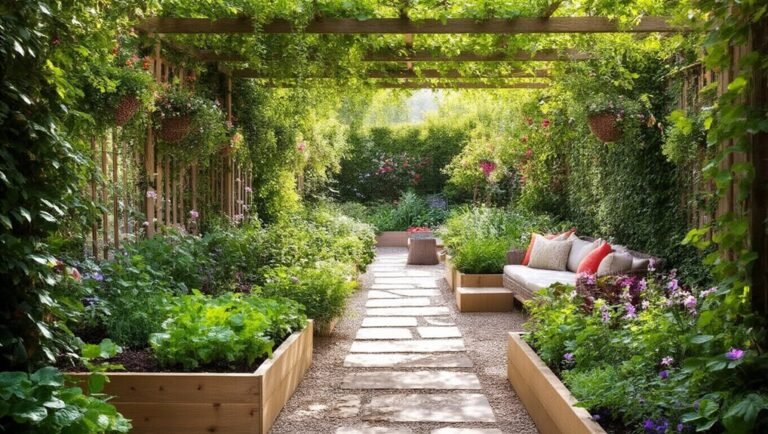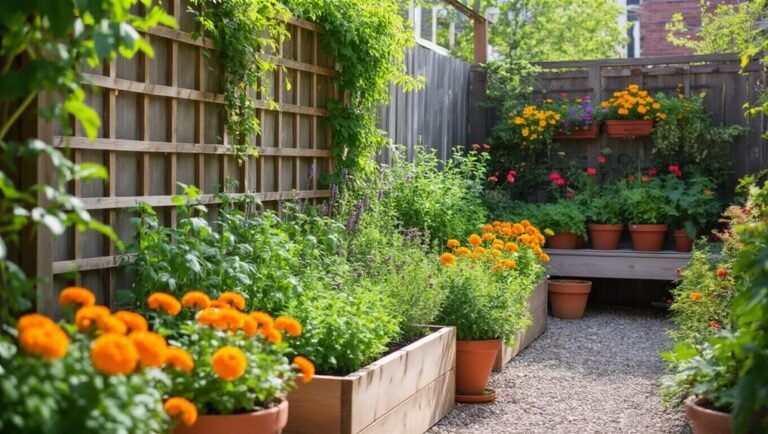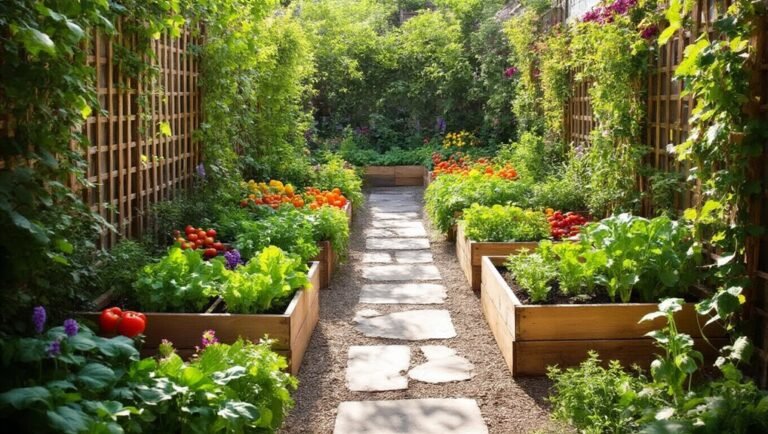Starting a backyard garden is easy and fun! You can begin with a simple flower bed, select a sunny spot, and choose easy-to-grow flowers like marigolds or zinnias. If space is tight, try a container garden filled with herbs or colorful blooms. For a bountiful harvest, build a raised vegetable bed. Want to attract pollinators? Incorporate plants that benefit local wildlife. There’s even more to explore to enhance your garden experience!
Key Takeaways
- Start with a simple flower bed using easy-to-grow flowers like marigolds or zinnias in a sunny spot.
- Create a container garden with quality soil and suitable plants for easy maintenance and flexibility.
- Build a raised vegetable bed using untreated wood or bricks for a productive and organized growing space.
- Try vertical gardening by utilizing walls or trellises to maximize space and add visual interest.
- Incorporate herbs into your garden with easy-to-grow varieties for culinary use and attractive displays.
Start With a Simple Flower Bed
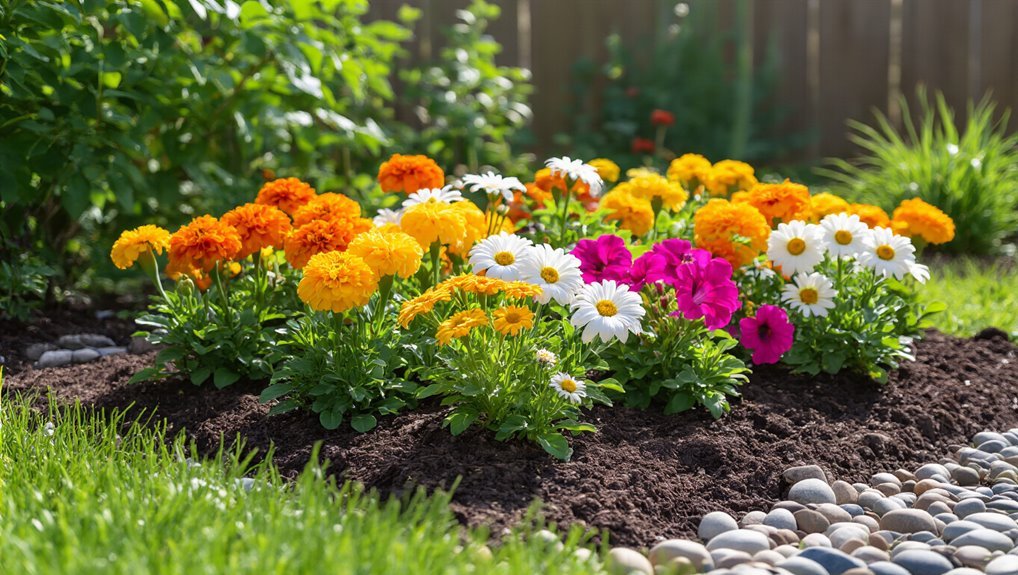
If you’re new to gardening, starting with a simple flower bed is a great way to dive in. Choose a sunny spot in your yard, as most flowers thrive in sunlight.
Begin by clearing the area of weeds and debris. Next, select a mix of easy-to-grow flowers like marigolds, daisies, or zinnias. These blooms not only add color but also attract pollinators. Using plant pots nearby can help you experiment with different flower varieties and add flexible accents to your space.
Plant them according to their spacing requirements, and don’t forget to water regularly, especially during dry spells. Adding mulch helps retain moisture and suppress weeds. One of the key benefits of using mulch is that it can improve soil health and reduce the need for frequent watering.
As you watch your flowers grow, you’ll gain confidence and experience, setting the stage for more ambitious gardening projects in the future. Enjoy the beauty and satisfaction your flower bed brings!
Create a Container Garden
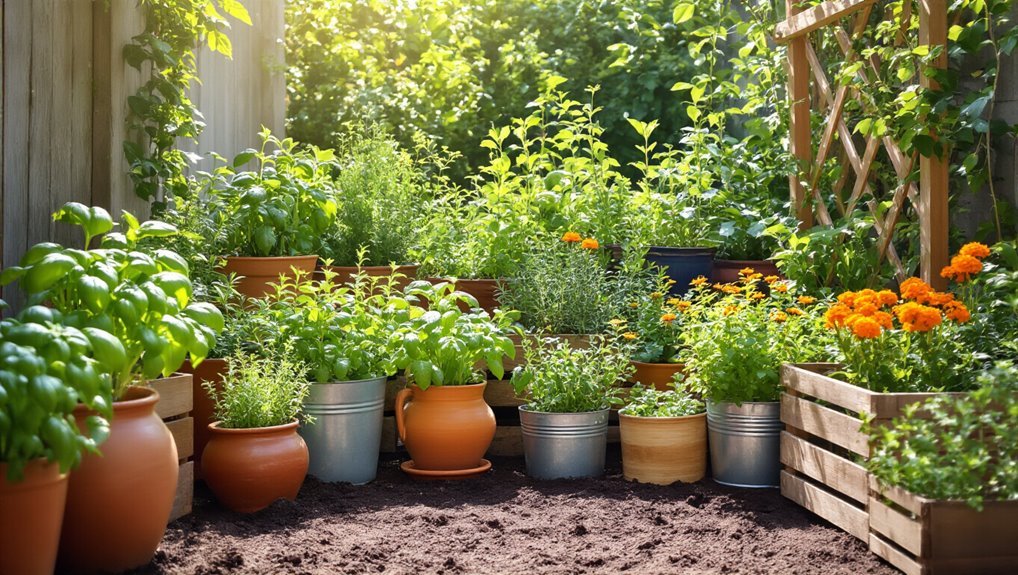
After enjoying the colorful blooms of your flower bed, consider expanding your gardening experience with a container garden.
Container gardening is a fantastic way to grow plants in limited spaces, and it’s easy to get started. You can choose from various containers, such as pots, hanging baskets, or even repurposed items. For best results, start your plants with garden soil that is specifically blended to promote healthy root development and thriving plants.
To create a thriving container garden, keep these tips in mind:
- Choose the right plants: Select species that thrive in your climate and fit the container size.
- Use quality potting soil: It ensures proper drainage and nourishment for your plants.
- Water regularly: Containers can dry out quickly, so check moisture levels frequently.
- Fertilize as needed: Container plants often need extra nutrients, so use a balanced fertilizer.
For even easier maintenance, consider using Self-Watering Planters in your container garden, which help keep your plants hydrated with minimal effort.
Happy gardening!
Build a Raised Vegetable Bed
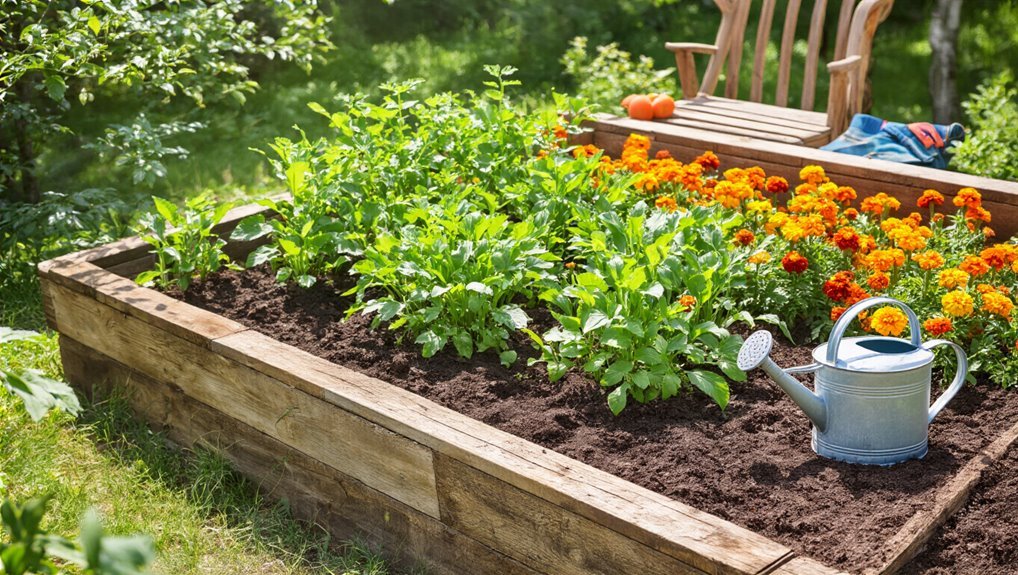
Building a raised vegetable bed can transform your gardening experience and make it easier to grow fresh produce right in your backyard. Start by selecting a sunny spot and gather materials like untreated wood or bricks. Aim for a bed that’s at least 4 feet wide and 8 feet long, allowing easy access from all sides.
Next, level the ground and construct the frame, ensuring it’s sturdy. Using a gardening tool set can help streamline the building and planting process, making tasks like digging, measuring, and planting much simpler. Fill the bed with a mix of quality soil and compost to nourish your plants. Choose vegetables that suit your climate and space, and plant them according to their needs.
With proper watering and care, you’ll enjoy a bountiful harvest. Raised beds not only enhance aesthetics but also provide better drainage and soil quality. For more inspiration, explore the variety of raised garden beds available to suit any backyard style and gardening need.
Try Vertical Gardening
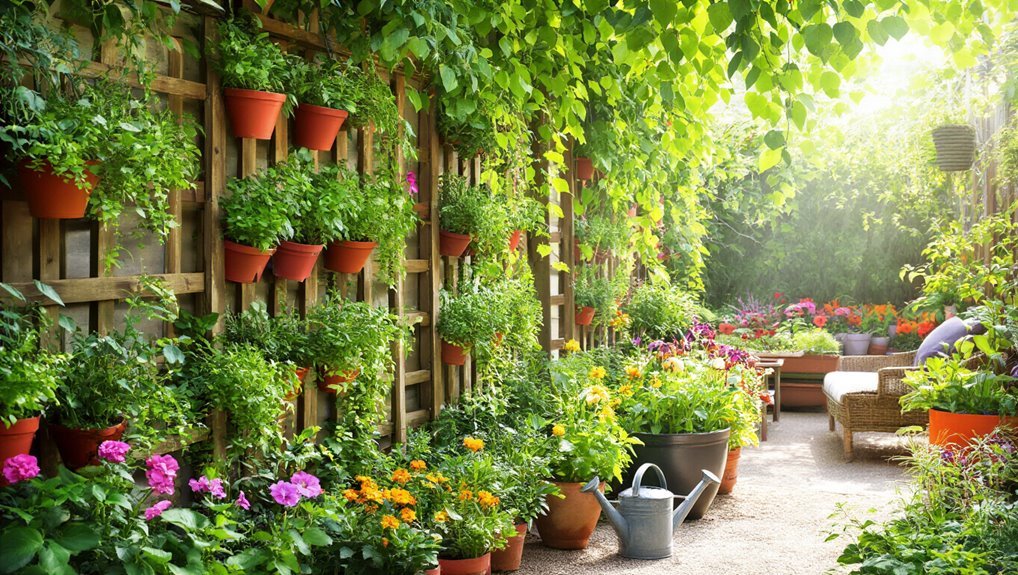
Whether you’re short on space or just want to add a creative touch to your garden, vertical gardening is an excellent option.
By utilizing walls, fences, or even hanging structures, you can grow plants upwards, maximizing your available area. This method not only saves space but also creates a stunning visual impact. For those looking to expand their gardening skills, plant propagation stations can be a beautiful and functional addition to your vertical garden setup.
Here are some ideas to get you started:
- Use wall planters: Attach containers directly to your wall for a beautiful display.
- Build a trellis: Train climbing plants like beans or cucumbers to grow vertically.
- Repurpose pallets: Transform old pallets into vertical planting systems.
- Hanging baskets: Suspend baskets from hooks to add dimension and color.
Consider using Vertical Garden Kits for an easy and organized way to start your own vertical garden at home. Try vertical gardening, and watch your backyard flourish!
Incorporate Herbs Into Your Garden
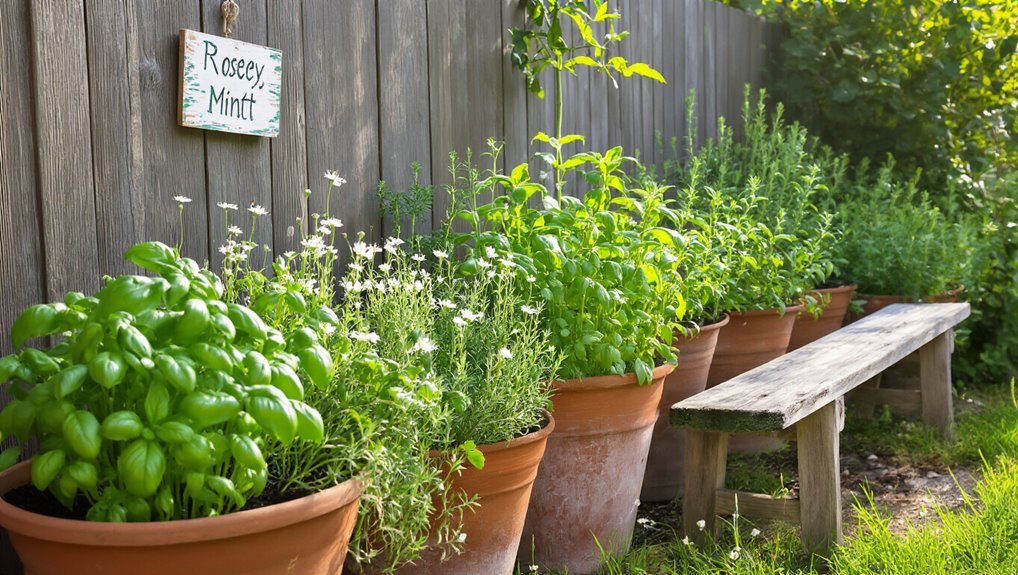
Incorporating herbs into your garden not only enhances the flavor of your meals but also adds a delightful aroma and vibrant greenery to your space.
Start with easy-to-grow herbs like basil, parsley, and mint. They thrive in containers or garden beds and require minimal maintenance. Make sure to choose a sunny spot, as most herbs love sunlight. If you want to enjoy fresh herbs year-round, you can try growing them with an indoor herb garden setup.
You can plant them in rows or mix them with flowers for a beautiful display. Regularly snipping the leaves promotes growth and keeps your herbs healthy.
Plus, you’ll enjoy the fresh, fragrant scent every time you step outside. With just a little effort, you can create a lush herb garden that elevates your cooking and beautifies your backyard. If you want a convenient way to get started, consider using Herb Garden Kits with Seeds and Pots designed for beginners, which make growing fresh herbs at home even easier.
Design a Pollinator-Friendly Space
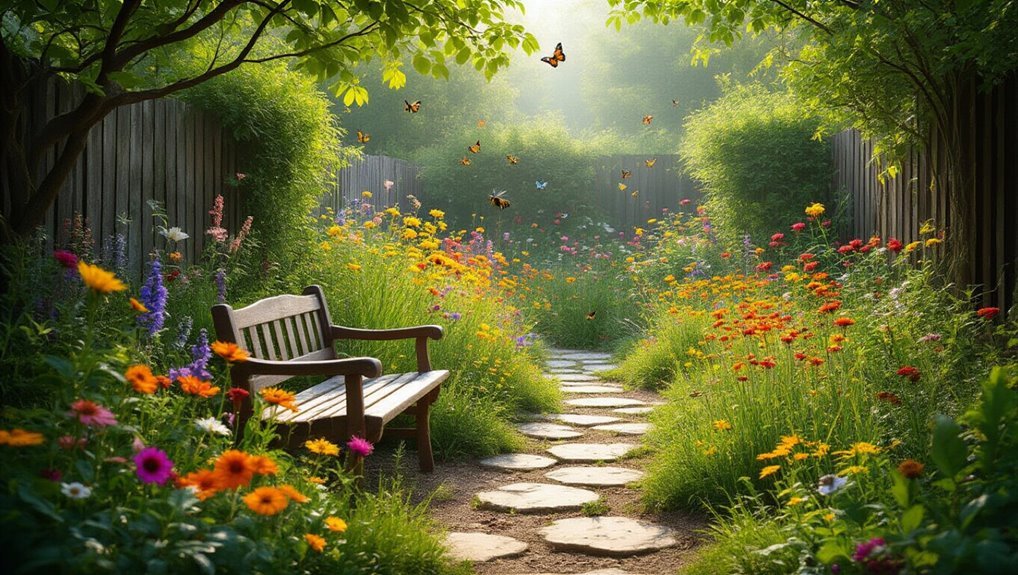
Creating a vibrant herb garden naturally attracts beneficial pollinators like bees and butterflies, which play a vital role in your backyard ecosystem. Incorporating insect repellent plants such as citronella into your garden can help keep unwanted pests at bay while still supporting pollinators.
To design a pollinator-friendly space, you’ll want to consider the following:
- Choose native plants: Native flowers provide essential nectar and pollen, supporting local pollinators.
- Plant in clusters: Grouping flowers together makes it easier for pollinators to find food sources.
- Provide water sources: A shallow dish or birdbath with rocks helps pollinators drink safely.
- Avoid pesticides: Chemicals can harm pollinators, so opt for organic gardening methods instead.
Adding a bee hotel to your garden is another effective way to support pollinators, as these structures provide safe nesting sites for solitary bees.
Use Garden Decor to Enhance Your Space
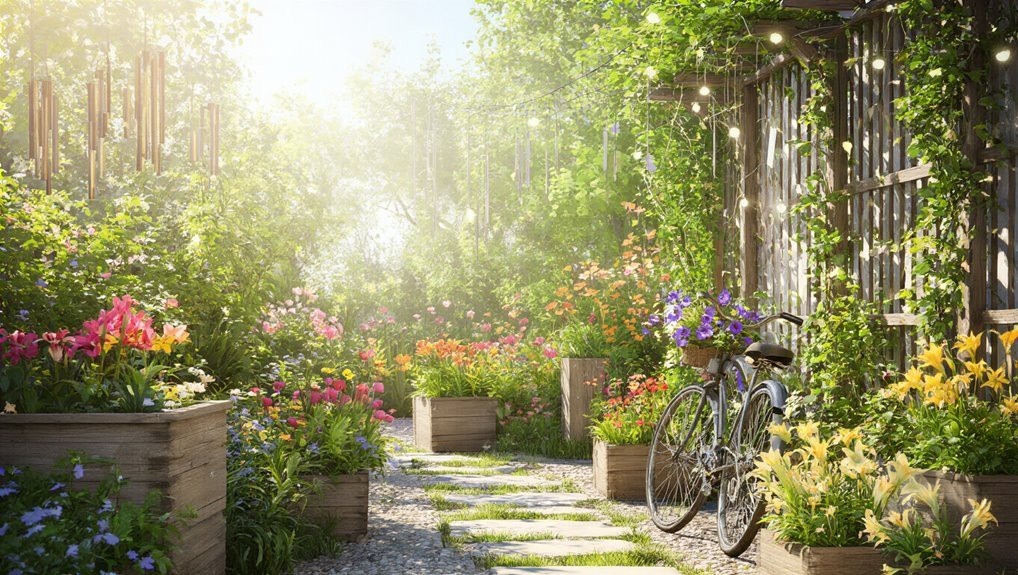
As you transform your backyard garden into a personal oasis, adding decorative elements can elevate its charm and personality.
Consider placing colorful garden statues or whimsical wind chimes to create focal points that draw the eye. Use decorative pots to house your favorite plants; they not only provide a pop of color but also enhance the overall aesthetic. Adding decorative plant stakes is an easy way to bring both height and visual interest to your garden beds.
String lights can add a magical glow during evening gatherings, making your garden a cozy retreat.
Don’t forget to incorporate a stylish birdbath or feeder to attract feathered friends, adding life and movement to your space.
With thoughtful decor choices, you’ll create a welcoming atmosphere that reflects your style and invites relaxation.
You can easily enhance your outdoor space by choosing from a variety of beautiful garden statues that suit your personal taste and garden theme.
Your backyard will become a delightful escape you’ll love to share.
Frequently Asked Questions
What Tools Do I Need to Start a Backyard Garden?
To start a backyard garden, you’ll need basic tools like a trowel, gloves, pruning shears, a watering can, and a rake. These essentials make planting and maintaining your garden much easier and more enjoyable.
How Much Sunlight Do Plants Need in a Garden?
Plants generally need at least six hours of direct sunlight daily to thrive. You’ll want to observe your garden’s sun exposure throughout the day, ensuring each plant gets enough light for healthy growth.
What Types of Soil Are Best for Gardening?
Imagine your plants dancing in rich, nurturing soil. For gardening, loamy soil’s your best friend, offering a perfect balance of sand, silt, and clay. It retains moisture while draining excess water, creating a thriving environment.
How Often Should I Water My Garden?
You should water your garden deeply once or twice a week, depending on the weather. Check the soil moisture regularly; if it feels dry an inch down, it’s time to water.
When Is the Best Time to Start Planting?
Just like a painter waits for the perfect light, you should start planting when the soil warms up, typically in spring. It’s the ideal time for seedlings to thrive, growing vibrant and strong under the sun.
Conclusion
As you stand in your vibrant backyard, surrounded by colorful blooms and the sweet scent of fresh herbs, you’ll feel the joy of your gardening journey. Each flower and vegetable you’ve nurtured brings life to your space, inviting buzzing bees and fluttering butterflies. With a little creativity and care, your garden becomes a sanctuary, a place where you can relax and connect with nature. So grab your gloves and dig in—your green oasis awaits!
